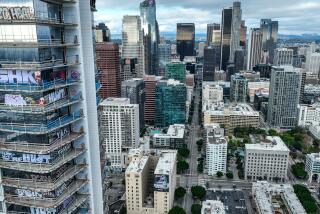Getty lab cleans Jackson Pollock’s 1943 ‘Mural.’ What a difference.
When does a Jackson Pollock painting look more like a Jackson Pollock painting?
Simple: When it’s clean.
That’s the not-altogether surprising thought that came to mind when I dropped by the J. Paul Getty Museum’s conservation lab the other day to check out progress on Pollock’s monumental 1943 “Mural.” Star of the collection at the University of Iowa Museum of Art, the epic painting had arrived in Los Angeles a year ago for extensive treatment.
CHEAT SHEET: Fall arts preview
Conservators have recently finished removing the coat of varnish apparently applied to the surface sometime in the 1970s -- no small task for 160 square feet of canvas (it’s roughly 8 feet tall and 20 feet wide). It’s to be expected that a newly cleaned painting will look somewhat different than it had, but I was frankly unprepared for just how different -- how fresh and kinetic -- “Mural” looks now.
Color contrasts are emphatic. Patches of white canvas are bright rather than dim. While wholly abstract, several flickering suggestions of animal forms are vivid. Layers of visual space have opened up, created by what the artist called his “stampede” of painterly shapes and rhythms.
The gestural dynamism known to have had such an impact almost 70 years ago, when the commissioned painting was first unveiled in collector Peggy Guggenheim’s Manhattan apartment, has returned in force. My jaw dropped.
The veil of varnish had tamped everything down. Perhaps its most detrimental effect was the uniform sheen of reflected light across the surface that it caused. In hindsight, “Mural” looked less like a painting than like a giant photo-mural of a painting.
Not anymore. “Mural” is back.
CRITICS’ PICKS: What to watch, where to go, what to eat
The next job for conservators will be to design a big, sturdy new stretcher for it. That will first require deciding whether to make it a precise rectangle or one that will take into account the picture’s slight downward bow. (The canvas appears to sag slightly in the center, pulling up the bottom edges at the right and left and leaving sections of unpainted canvas.) Once the chosen design is built, the entire canvas will be removed from the current stretcher and affixed to its new support.
The aim is to have everything finished by the spring. Then “Mural” will be put on temporary display at the Brentwood museum before returning home to lucky Iowa. If you’ve seen the painting before, be prepared to be surprised.
ALSO:
Fall Arts Preview 2013: The Cheatsheet
Eli Broad’s advice to budding art collectors: Go slow
L.A. Phil musicians’ base pay to reach $154,336 under new contract
More to Read
The biggest entertainment stories
Get our big stories about Hollywood, film, television, music, arts, culture and more right in your inbox as soon as they publish.
You may occasionally receive promotional content from the Los Angeles Times.











